Medical Disclaimer: This article is intended for informational purposes only and does not substitute professional veterinary advice. Always consult your veterinarian to tailor an exercise plan for your pet’s specific needs.
Table of Contents
Introduction
Is your dog restless, chewing things, or gaining weight? These are often signs your dog might need more activity. As a veterinarian, I’ve seen firsthand how the right dog exercise routine can turn a bored or anxious dog into a calm, content companion. But how much is enough—and how much is too much? That depends on your dog’s breed, age, and health.
In this guide, I’ll walk you through how to customize dog exercise for your pup—whether you have a playful puppy, a senior with sore joints, or a high-energy herding breed. With the right activities, you can boost your dog’s health, happiness, and behavior.
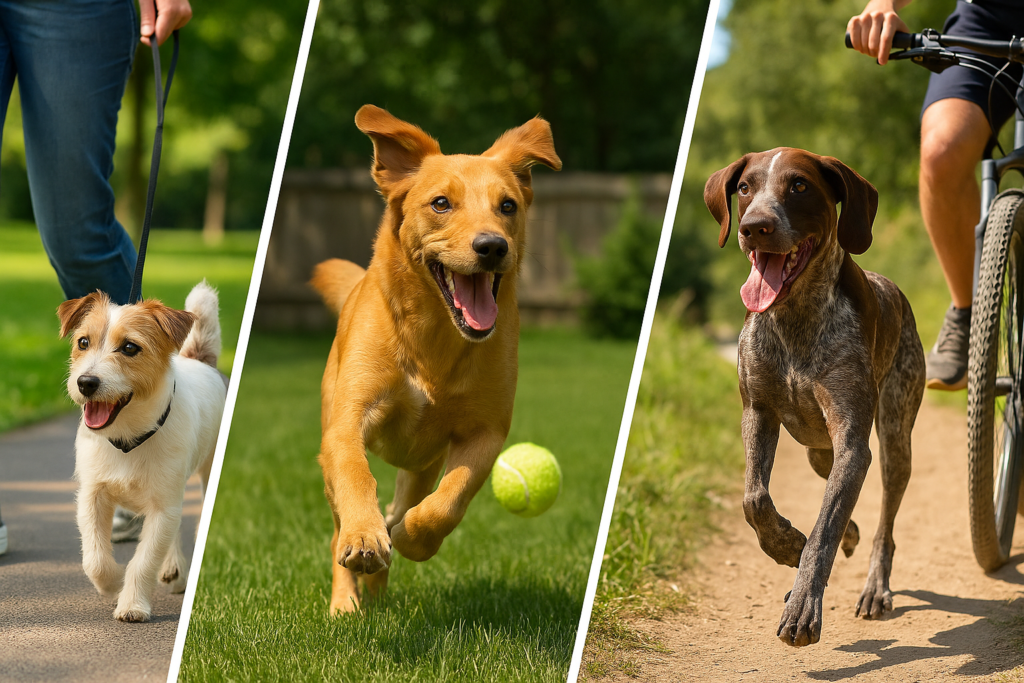
Key Takeaways
- Most dogs need between 30 minutes and 2 hours of dog exercise daily, depending on breed, age, and health.
- High-energy breeds like Labs or Border Collies may need more than 90 minutes a day, while brachycephalic or senior dogs require gentler routines.
- Dog exercise isn’t just physical—mental stimulation (like puzzle games or scent work) is equally important.
- Puppies need short, age-appropriate bursts of play, and seniors benefit from low-impact walks or swimming.
- Signs of under- or over-exercise include destructive behavior, weight changes, and fatigue—watch your dog’s cues.
- Tailor your dog’s activity to the weather, health conditions, and comfort level, and consult your vet for personalized advice.
Why Dog Exercise Matters
Regular exercise is essential for more than just keeping your pet trim—it supports every system in their body and mind. From maintaining healthy weight to boosting mood and behavior, staying active helps dogs live longer, happier lives.
Physical Health Benefits
- Weight control: Just like people, dogs gain weight when they consume more calories than they burn. Routine exercise of dogs helps prevent obesity, which is linked to diabetes, joint issues, and heart disease.
- Joint and muscle health: Movement builds muscle tone and maintains joint mobility. This is especially important for growing puppies and large breeds prone to arthritis.
- Cardiovascular support: Consistent dog exercise keeps your dog’s heart strong, improves lung capacity, and supports overall endurance.
Mental and Emotional Benefits
Reduces anxiety and boredom: A tired dog is a happy dog. Regular activity decreases unwanted behaviors like chewing, barking, or digging.
- Boosts confidence: Shy or anxious dogs often become more confident when given structured, stimulating tasks like agility or sniffing games.
- Strengthens your bond: Shared walks, games, and training build trust and deepen your connection. Many of my clients say their dog’s behavior improved dramatically once they made dog exercise a daily routine.
How Breed and Size Affect Dog Exercise Needs
One of the biggest factors in tailoring the right exercise routine is your dog’s breed and size. Genetics often determine how much energy your dog naturally has—and how they prefer to burn it off.
High-Energy Breeds
Dogs bred for work, such as Labrador Retrievers, Border Collies, or Australian Shepherds, need vigorous dog exercise—often over an hour daily. Without enough stimulation, they may develop destructive habits out of boredom.
- Ideal activities: long walks, runs, fetch, agility, hiking
- Daily goal: 60–90+ minutes of varied dog exercise
Moderate-Energy Breeds
Terriers, spaniels, and similar breeds are playful and curious, needing moderate amounts of dog exercise—usually 45–60 minutes daily. They enjoy both mental and physical activities.
- Ideal activities: brisk walks, puzzle games, tug, supervised digging
- Daily goal: about 1 hour of combined physical and mental play
Low-Energy or Brachycephalic Breeds
Breeds like Pugs, Bulldogs, and Shih Tzus often need shorter, gentler sessions of dog exercise. These dogs are more sensitive to heat and fatigue quickly.
- Ideal activities: short leash walks, indoor play, scent games
- Daily goal: 20–30 minutes, split into small sessions
Size Considerations
- Small dogs: Often meet dogs need indoor exercises, but still benefit from structured play and short walks.
- Large/giant dogs: Require more space and may benefit from swimming or low-impact activities to protect joints.
Pro Tip: Always tailor your dog exercise plan based on your dog’s individual tolerance and watch for signs of overexertion.
Dog Exercise by Age and Life Stage
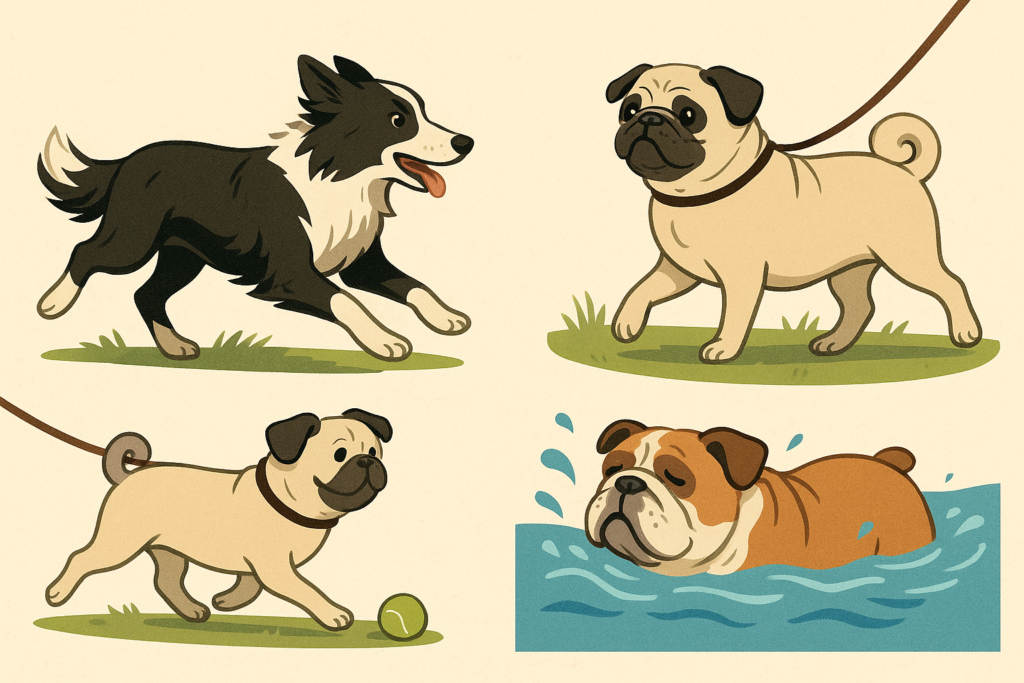
Your dog’s age plays a huge role in how much and what kind of dog exercise they need. As a veterinarian, I often advise pet owners to adjust routines as their dog grows or ages.
Puppies
Puppies have boundless energy but immature joints. Too much dog exercise early can damage growth plates.
- Rule of thumb: 5 minutes per month of age, twice daily
- Activities: short leash walks, supervised play, socialization
- Avoid: long hikes, jumping, stairs
Example: A 4-month-old puppy should get about 20 minutes of activity twice a day. Include rest periods and gentle play.
Adult Dogs
Once grown, dogs are in their peak physical shape and can usually handle the full range of dog exercise activities.
- Most adult dogs need 30 minutes to 2 hours exercise daily
- High-energy dogs often need 2+ activity sessions per day
- Mix cardio (walks, runs) with enrichment (training, games)
Senior Dogs
Older dogs may slow down, but dog exercise remains vital for joint flexibility, circulation, and weight control.
- Short, low-impact walks (10–15 min 2–3x/day)
- Ideal activities: swimming, gentle play, soft surfaces (grass)
- Avoid: jumping, slippery floors, intense fetch
Tip: Monitor for limping or reluctance and talk to your vet if your senior seems stiff or fatigued after exercise.
Types of Dog Exercise and Activities
The best dog exercise routine includes both physical movement and mental stimulation. Changing things up helps prevent boredom and keeps your dog engaged and happy.
Walking
- Most accessible and essential form of exercise
- Benefits: joint health, heart function, and mental enrichment through sniffing
- Tip: Aim for 30–60 minutes a day, adjusted by breed and weather
Running or Jogging
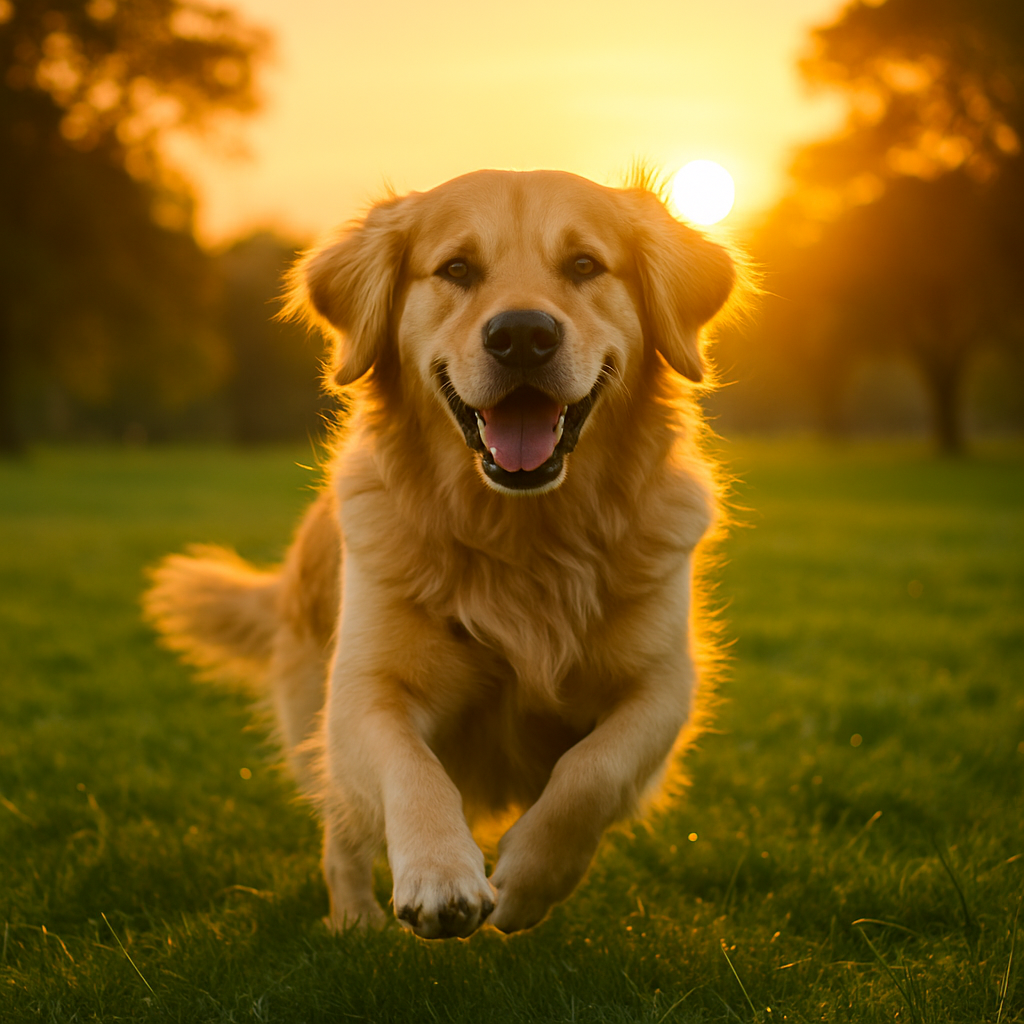
- Great for high-energy dogs like Vizslas or German Shorthaired Pointers
- Wait until growth plates close (usually 12–18 months)
- Build endurance slowly and avoid hot pavement
Fetch and Play Games
- Classic dog exercise that boosts cardio and builds muscle
- Use a ball launcher or flirt pole for added excitement
- Caution: Avoid hard surfaces to reduce joint strain
Swimming
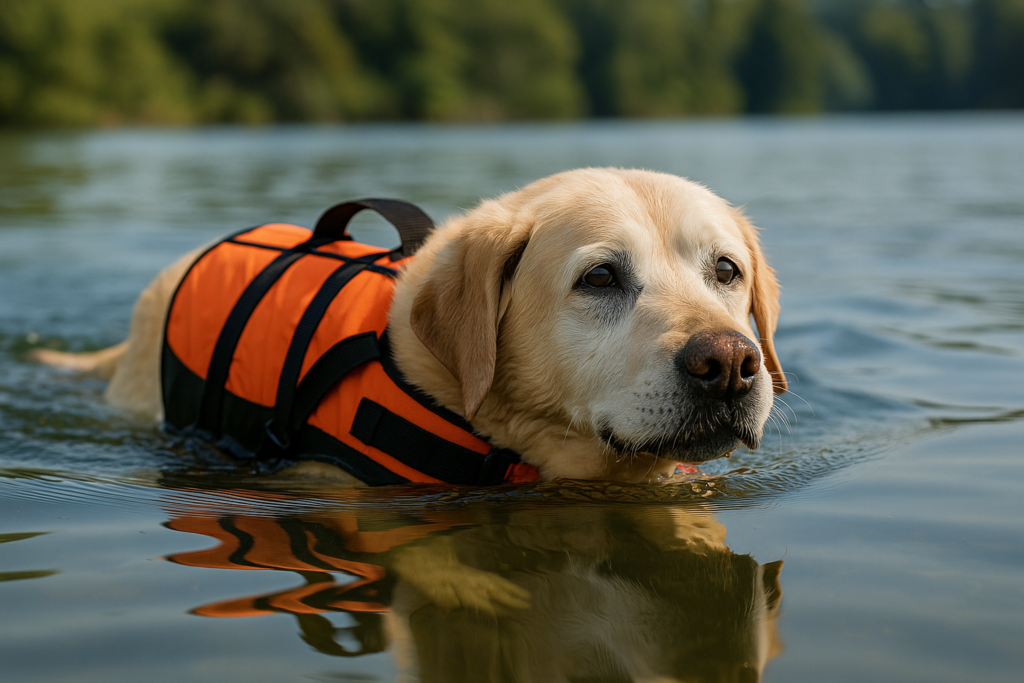
Also visit: https://doglifeexpert.com/best-dog-food-for-allergies-2025/
- Ideal for dogs with arthritis or joint concerns
- Provides full-body, low-impact dog exercise
- Always supervise and consider a dog life vest
Indoor Games
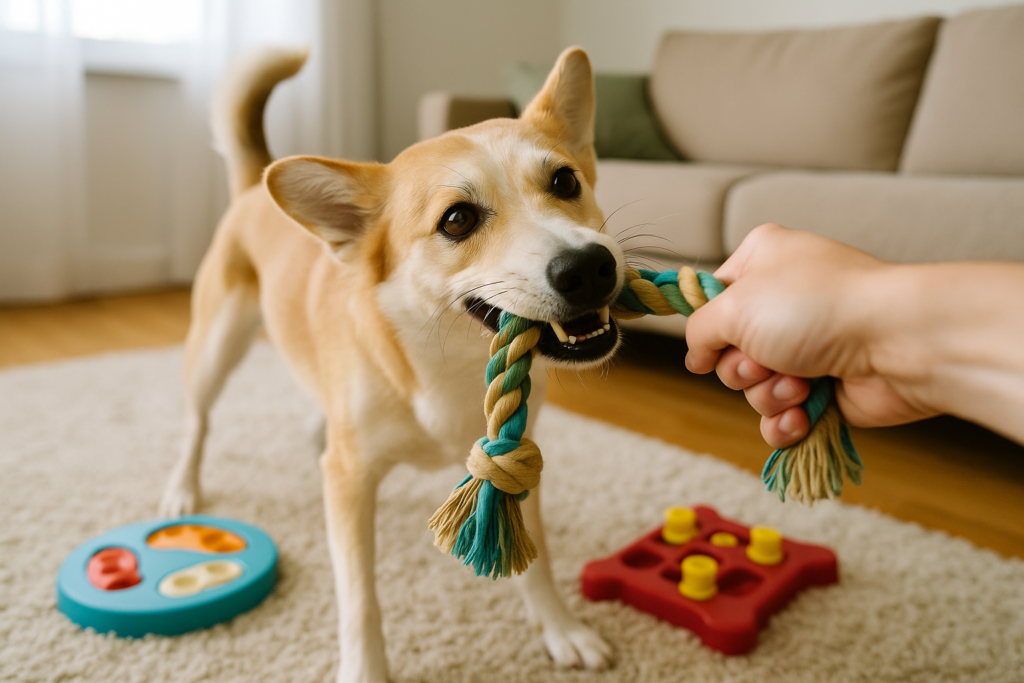
- Great for rainy days or small spaces
- Options: tug-of-war, puzzle toys, hallway fetch, hide-and-seek
- Flirt poles and scent games keep the mind and body active
Agility and Dog Sports
- Excellent for smart, energetic breeds
- Combines obedience training with high-energy dog exercise
- Sports like flyball or dock diving can be fun alternatives
Mental Work = Real Exercise
- Trick training, nose work, and treat puzzles are mentally tiring
- Mental effort can be just as effective as a walk
- Mix these with physical routines for a balanced dog exercise plan
https://vcahospitals.com/know-your-pet/the-benefits-of-walking-your-dog
Signs Your Dog’s Exercise Routine Needs Adjusting
Not every dog will clearly show when their exercise routine is out of balance—but there are some common signs to watch for. As a vet, I’ve had clients describe behavior problems that vanished once the dog got the right amount of activity.
Signs of Too Little Exercise
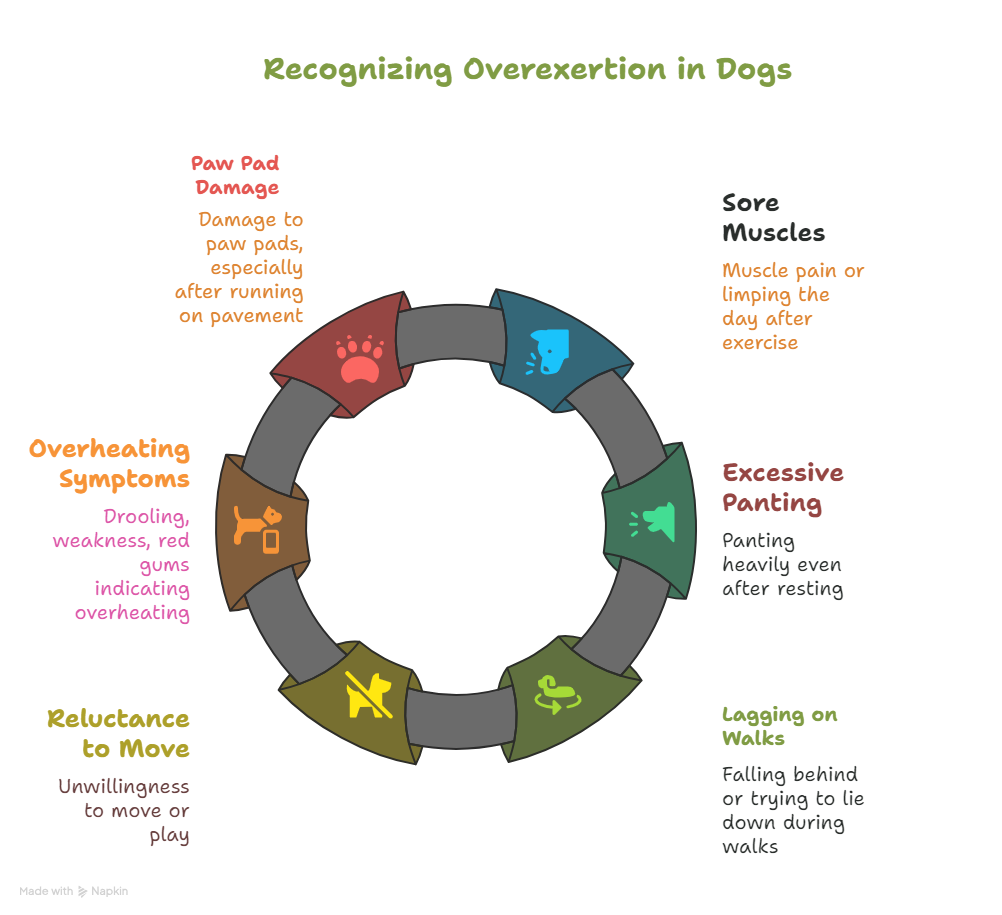
Signs of Too Much Exercise
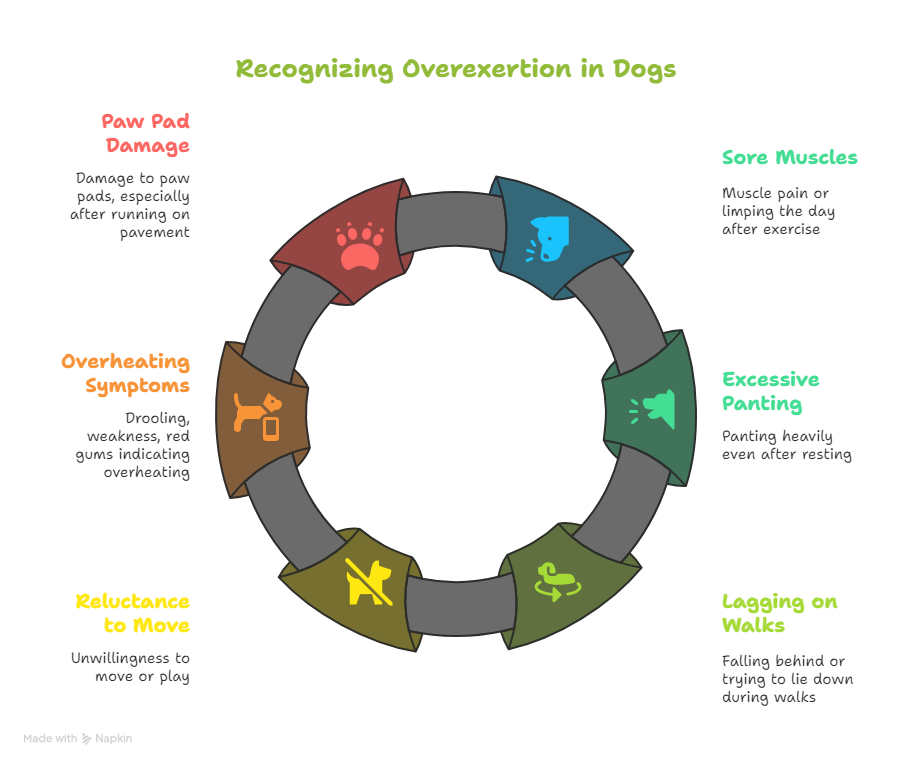
When to See Your Vet
If your dog shows signs of injury, fatigue, or sudden behavioral changes after dog exercise, book a check-up. Overexertion can worsen arthritis or mask underlying conditions like hypothyroidism or heart disease.
Remember: the goal is a dog who’s “happily tired,” not wiped out or limping.
Adapting Dog Exercise for Age and Health Conditions
Every dog is unique, and their dog exercise needs evolve with age, weight, and medical conditions. I often adjust exercise plans for patients based on breed predispositions and chronic issues.
Puppies and Growth
- Opt for safe play and structured walks
- Social play is still valuable dog exercise, even in short sessions
Senior Dogs
- Prioritize joint-friendly activities: swimming, gentle leash walks
- Avoid icy sidewalks or hard surfaces
- Keep sessions short but regular to prevent stiffness
Overweight or Obese Dogs
- Start with 5–10 minute walks, 2–3x a day
- Incorporate food puzzles to combine calorie control with movement
- Swimming or slow leash walking are ideal low-impact options
Dogs with Health Conditions
| Condition | Adjusted Dog Exercise |
|---|---|
| Arthritis | Short walks on grass, swimming, avoid stairs |
| Heart Disease | Vet-supervised slow walks, indoor play |
| Hip Dysplasia | Low-impact play, no jumping |
| Respiratory issues (e.g. brachycephalics) | Avoid heat, short walks only |
| Back problems (Dachshunds, etc.) | Gentle movement, no fetch or stairs |
| Post-surgery recovery | Leash walks only as advised by vet |
Environmental Adjustments
- Heat: Walk early morning/evening, avoid hot asphalt, carry water
- Cold: Use dog coats, avoid icy patches, shorten walk time
- Rain/Snow: Substitute with indoor dog exercise games
Pro Tip: Always follow your vet’s recommendations for exercise if your dog has a chronic condition or is on medication.
Practical Dog Exercise Tips for Busy Pet Parents
Whether you live in a condo or work full-time, your dog still needs daily activity. These simple tips can help fit effective dog exercise into a hectic lifestyle.
Build a Routine That Works
- Consistency is key: Dogs thrive on routines. Try to walk or play at the same times daily.
- Break it up: 3 x 20-minute sessions are often more effective than 1 hour-long walk.
- Use a mix: Combine walks, training, indoor games, and sniffing sessions to create a balanced dog exercise schedule.
5-Minute Home Dog Exercise Checklist
On busy or rainy days, use this quick checklist:
- 2 minutes of tug-of-war
- 1 minute of fetch down a hallway
- 1 minute of nose work (hide treats under cups)
- 1 minute of sit-down-stand “puppy push-ups”
That’s a quick but engaging burst of dog exercise indoors.
Sample Weekly Routine (Adult Dog)
| Day | Morning | Evening |
|---|---|---|
| Mon | 20-min walk + 5-min training | 15-min fetch |
| Tue | Indoor puzzle toy | 30-min leash walk |
| Wed | 15-min jog | 10-min nose work |
| Thu | Short walk + training | Tug game & toy rotation |
| Fri | 30-min trail walk | Gentle massage/stretch |
| Sat | Agility park or long hike | 10-min puzzle feeder |
| Sun | Swim or beach play | Rest + cuddles |
Typical Canadian Cost Table (Add-On)
| Activity | Estimated Cost |
|---|---|
| Dog walker (30 mins) | $15–$25 |
| Doggy daycare (day) | $30–$45 |
| Puzzle toys | $20–$40 |
| Flirt pole | $25 |
| Swim therapy (per session) | $40–$75 |
Budget tools like flirt poles or treat-dispensing balls make affordable indoor dog exercise possible too.
Frequently Asked Questions About Dog Exercise
1. How long should I walk my dog each day?
Most adult dogs benefit from 30 to 60 minutes of daily exercise, often split into two walks. High-energy breeds may need more, while smaller or senior dogs may need less.
2. What if my dog doesn’t like walking?
Try different forms of dog exercise like fetch, tug, or puzzle games. Some dogs prefer off-leash play, swimming, or nose work. The key is finding what motivates them.
3. Can I exercise my dog in winter?
Yes, just adjust for safety. Use a dog coat and paw balm, shorten walks, and switch to indoor dog exercise when it’s icy. Puzzle toys and stair games work well.
4. Is a dog treadmill safe?
With proper training, a dog treadmill can be a safe supplement—but not a substitute for outdoor exercise. Always supervise and start slowly.
5. Can my dog play right after eating?
Wait 30–60 minutes after meals before vigorous dog exercise, especially for large breeds, to reduce the risk of bloat.
6. Do older dogs still need exercise?
Absolutely! Senior dogs need gentle dog exercise to maintain muscle tone and joint mobility. Adjust pace, use soft terrain, and consult your vet.
Conclusion: The Power of Personalized Dog Exercise
There’s no one-size-fits-all answer when it comes to dog exercise—and that’s exactly why it matters so much. The right amount and type of activity can drastically improve your dog’s physical health, emotional balance, and even lifespan. Whether you’re raising a curious puppy, caring for a mellow senior, or keeping up with a high-octane working breed, dog exercise should be tailored, consistent, and enjoyable.
From my veterinary experience, I’ve seen how even small changes—like adding a second walk or introducing puzzle games—can transform a dog’s behavior, weight, and mobility. The most successful pet parents are the ones who observe their dog’s cues, keep routines flexible, and prioritize both physical and mental movement.
Remember:
- Make time for dog exercise daily—even if it’s just 15 minutes on a busy day.
- Rotate between activities: walking, play, training, and scent work all count.
- Adapt based on your dog’s breed, age, health, and personality.
- Don’t wait until your dog is restless, overweight, or sore—prevent issues with a consistent plan.
- Talk to your veterinarian for help designing the safest, most effective routine.
Your dog doesn’t need to be an athlete—but they do need to move. By committing to a fun, flexible dog exercise plan, you’re not just improving their health—you’re deepening the lifelong bond you share.
Because at the end of the day, a healthy, well-exercised dog is a happy one. And a happy dog makes for a happier home.

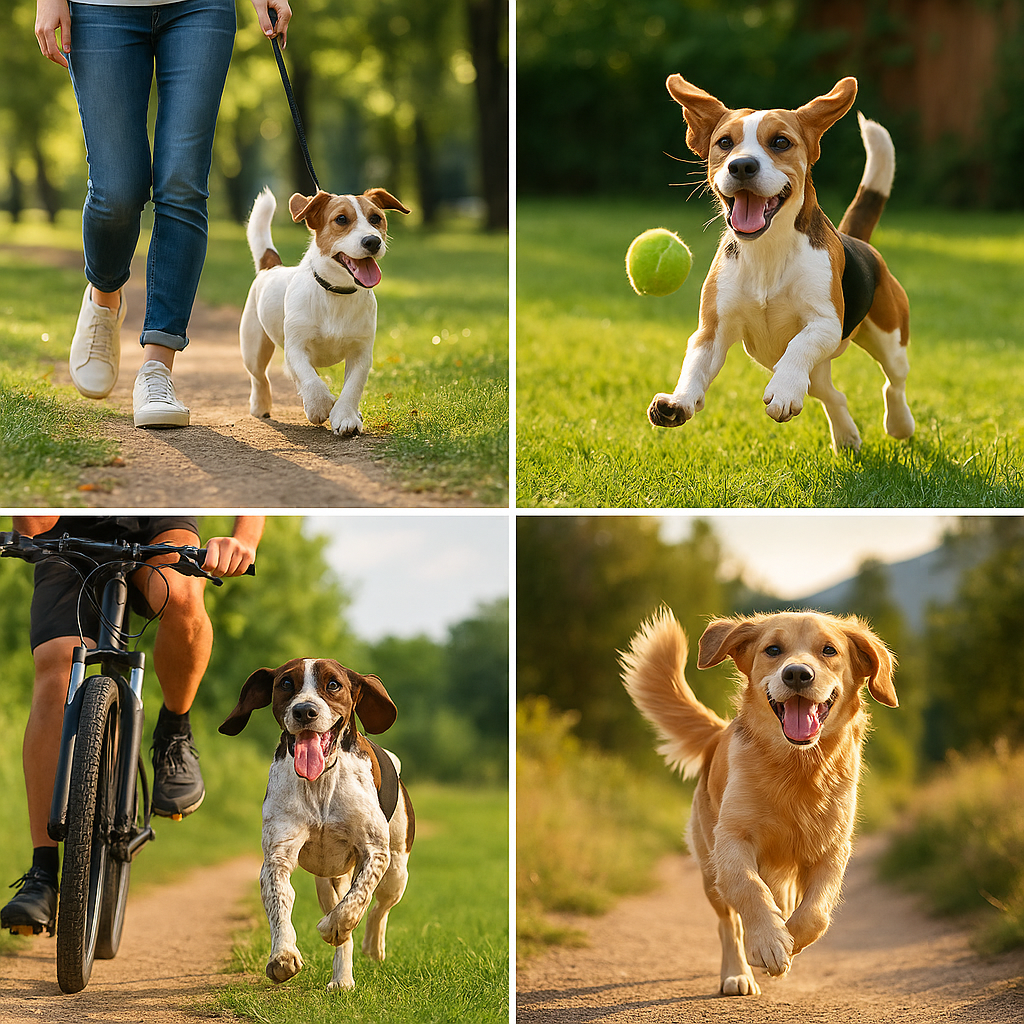
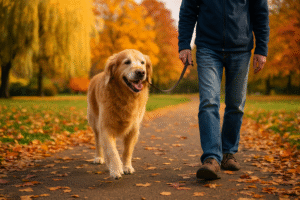
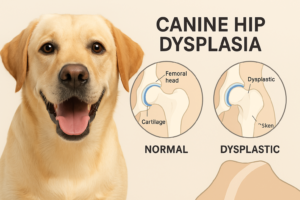

Pingback: The 5 Best Overweight Dog Exercises for a Healthier, Happier Pup